Before I get started, welcome to 2021! 🎉
As I casually dropped in my last article, I was lucky enough to preorder an Xbox Series X for launch day. The Series X, Series S, and PlayStation 5 are impressive machines, without question, though Microsoft and Sony (to a lesser extent) have launched with perhaps a pair of fairly lackluster launch day lineups. Of course, this new generation of Xboxes was supposed to launch with Halo: Infinite which would have satisfied a huge swath of Xbox devotees. That release getting pushed back was a major fail, but as a Halo fan I’m hopeful that the Halo: Infinite we end up with will be better for it.
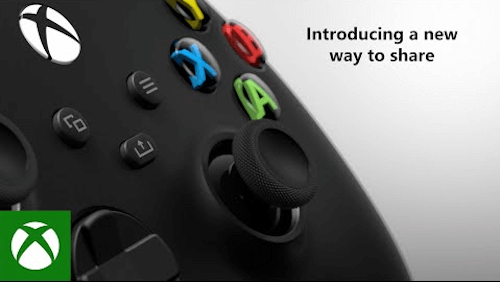
“Sharing is caring, after all.”
Beyond that one glaring issue, Microsoft treating the Series X|S as more of an extension of the Xbox One rather than an entirely new console generation suits me quite well. I’ll most definitely continue taking advantage of the Xbox One’s expansive library, which of course includes backwards compatibility with many Xbox 360 games and some original Xbox titles as well, only now with improved loading speeds and other enhancements. There’s also at least one Xbox One game I’ve been wanting to play that reportedly ran terribly on the original Xbox One that I’ve purposely delayed playing until I could upgrade to the Series X, actually, and given that I skipped over upgrading to the Xbox One X, this really is a notable jump in performance for me, even while still rocking a 1080p TV.
One more practical change, as minor as it might be, is the Xbox controller is finally catching up to the PS4’s with the addition of a “share” button, meaning I can at long last capture my own action shots of Xbox games with ease instead of having to plunder the nether regions of the Internet for screenshots for some of these blog posts. I know most people won’t care about this feature but, having already used it extensively for my Halo 3 game log, I can say I’m a fan.
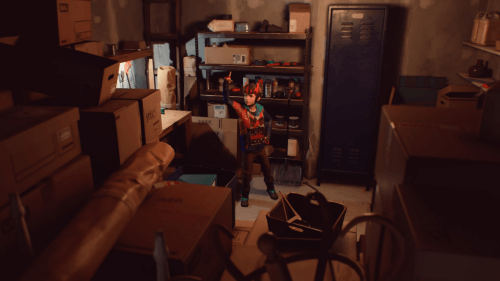
“Captain Spirit, ready to beat some Mantroid ass!”
I’ve not just been using my shiny new Xbox Series X to play ports of 13 year old Xbox 360 games though! My girlfriend and I had also started playing Life is Strange 2 just before the Series X launch, and managed to transition to playing the remaining episodes on the Series X with ease thanks to the wonder of automatic cloud saves. Life is Strange 2 is a much newer game, of course, but it’s not Series X|S enhanced, nor was it really pushing the hardware of even the original Xbox One, but hey, we have to start somewhere, right?
As I’d recommend to anyone reading this, we started our playthrough with The Awesome Adventures of Captain Spirit. In this free mini-episode you play as Chris, a young boy who lives a somewhat isolated life due to the difficulty his father is facing coping with the death of Chris’s mother. Chris is able to compensate a bit better by leaning into his huge imagination, with Captain Spirit being his superhero alter ego, for example. The game itself is typical Life is Strange fare, with the player navigating Chris through a variety of tasks around his home. The “slice of life” stuff is quite strong in this one, and Dontnod manages to paint a compelling picture of these characters in the short time we’re with them. We both left this episode really rooting for Chris and hoping to see him make a proper appearance in Life is Strange 2.
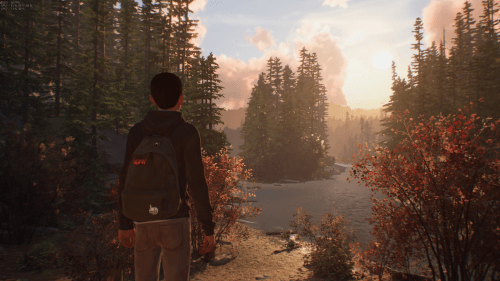
“Exploring the wilderness of the Pacific Northwest.”
In Life is Strange 2 you play as Sean, a teenager living with his dad and little brother in Seattle. Starting off with more slice of life mundanities, shit quickly escalates in unexpected and tragic ways, with Sean’s brother Daniel exhibiting some sort of supernatural powers (a recurring theme in Life is Strange, apparently) Sean and Daniel find themselves all alone and on the run. Without getting too much further into spoiler territory, this sets up the rest of the game as we follow Sean and Daniel’s journey, with the relationship between the brothers being the real highlight of both the story and the mechanics.
You’re constantly faced with decisions about how Sean interacts with Daniel, how you let him behave, and yes, how (and when) you let him use his powers. I personally took a very careful approach with him, always attempting to be a good influence on him despite the difficult situations we often found ourselves in throughout the course of the game, while also giving him an appropriate modicum of freedom and respect that children often crave but so rarely receive. That’s a bit more of a balancing act than you might think though, but I almost always left every episode satisfied with how I’d played as Sean when looking at the end of episode statistics.
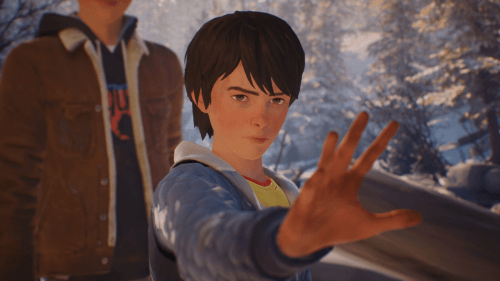
“With great kid brother power comes great older brother responsibility.”
It really is kind of an interesting take, not being the person with the power, but instead being the person next to the person with the power. In that way, the whole experience is a bit more grounded than the first Life is Strange, perhaps feeling a bit more like Before the Storm. The similarities don’t stop there though. Life is Strange 2 really focuses on those “slice of life” moments, character building, and decisions which were the real focus of BtS. Attempts to shoe in puzzles or action sequences are barely there at all, and I think that fits the tone of the stories Dontnod seems to like to tell better overall, personally.
The game has a similar look to the original Life is Strange and Before the Storm, though, again, as with BtS, leans into the stylization just a tiny bit more, and for the better. Like the former two games, it definitely has moments where the visuals really work, especially when paired with another fantastic Syd Matters soundtrack and some talented voice actors. The writing (notably, the character dialog) is also worlds better than what we encountered in the first Life is Strange. I do think I had more minor bugs and technical glitches in Life is Strange 2 though, especially in later episodes, but nothing terrible enough to ruin my experience – just oddities like odd bits of clipping, overlapping dialog, that kind of thing.
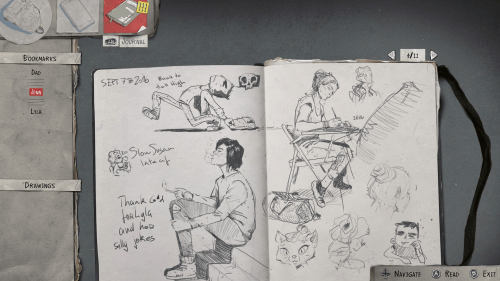
“Sean’s journal entries are short and (usually) fun.”
The new backpack and journal system is a nice upgrade from the former games. This both expands on those titles’ similar systems, yet somehow simultaneously makes it less intrusive. The journal entries are much more terse, consisting mostly of short thoughts, notes, and sketches related to recent events rather than the more complete transcriptions of the story, so they don’t take too long to review, yet still add a nice bit of extra exposition. This is particularly useful when it comes to filling the gaps from several timeline leaps that occur throughout the story.
Speaking of sketches, Sean’s a bit of an artist, and you’ll have several opportunities to sketch in your journal throughout the game. While the sketching mechanic itself feels a little half baked, the sketches themselves are pretty cool, and sitting down to sketch is yet another “slice of life” that serves to connect you with Sean. Like the photograph and graffiti mechanics from the former titles, this is basically a “collectible” system, though LiS2 also features a more tradition one of those too, where you can find various odd items in the world and squirrel them away in your inventory for achievements out of game, and the ability to use many of them to decorate your backpack in game. Fairly pointless, but a fun little addition.
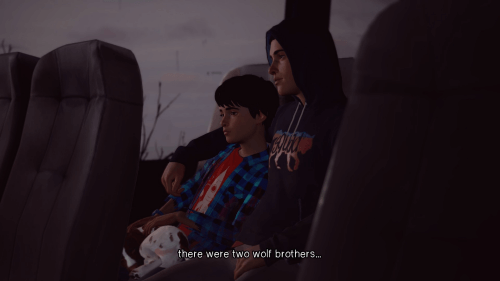
“After finishing the game, this one brings the feels.”
Back to the more important stuff though, the story eventually reaches its end, culminating in a final decision. In an interesting twist, keeping with the theme of Sean guiding his younger brother, the decision ends up not being yours alone. Whatever you pick is paired with Daniel’s response based on who he has become by that point in the game, which itself is dictated by numerous other decisions, both major and minor, you made regarding him throughout. The endings vary quite a bit, with one of them being pretty insane, and while there are ultimately only four endings with some variations thrown in, this felt far superior to the absolutely binary choice and corresponding ending you got at the end of Life is Strange. I was pretty happy with my ending, for the record!
Despite some significant hype from some reviewers and podcasts I frequent, Life is Strange 2 managed to avoid letting me down. I’m happy with Dontnod’s decision to only very loosely connect Life is Strange 2 to Life is Strange, as getting to know new characters in new settings, and in new situations, was a lot more interesting than needlessly rehashing the events of Life is Strange yet again. While it didn’t emotionally affect me quite as much as either of the previous games, it definitely still did, and that remains a rare, powerfully compelling thing to encounter in a game.
Something a bit more appropriate to let my Series X flex just a little, was Star Wars: Squadrons.
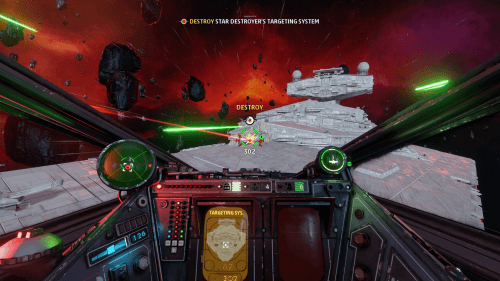
“X-wing versus Star Destroyer. Classic!”
I’m a big fan of the old LucasArts X-wing series and I’ve wished for something resembling a proper sequel for ages now. The closest was perhaps the Jump to Lightspeed expansion for Star Wars Galaxies, which while kind of cool in its own right, wasn’t quite a fit, never mind being attached to an expansive MMORPG weighing it down. Now with Star Wars: Squadrons, Motive, likely inspired by their work on the space battles from Battlefront II, has come out with a modern, online focused Star Wars space combat game of its own that is clearly heavily influenced by those older games.
I’m not sure where my expectations were when first checking the game out. I mean, EA made no secret that Squadrons was going to be a bit of a budget game, but it feels and looks plenty polished to me, pretty much nailing those Star Wars aesthetics. Zipping around a Star Destroyer in an X-wing, rolling and turning as you try to evade the Tie Interceptor on your tail, laser fire and explosions all around you? Yeah, it just looks flat out amazing if you’re a Star Wars nerd like me. The intermission cutscenes and in-game world menus (somewhat aping those seen in the original X-wing games and it’s ilk, such as Wing Commander) look reasonably nice too, despite them feeling more aimed at PC players using VR than fans of those old titles. Oh, and yes, there is full VR support here too! I don’t have a VR headset myself, but if I ever get one, Squadrons will be high on my list of games to try it out with.
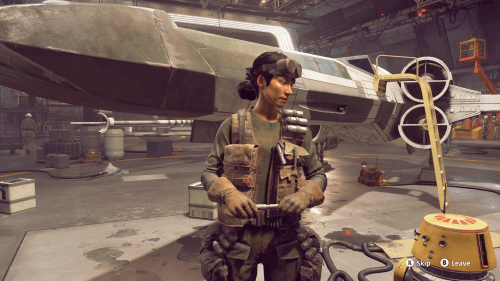
“Boring conversations in boring hangers.”
Despite being online focused, there is a single player campaign. I feel like it gets a bit of a bad rap, often being described as little more than a glorified tutorial, but it certainly feels like a full enough campaign to me. You’re tossed back and forth between pilots for the Empire, still reeling from the Emperor’s death, and the emboldened New Republic, who are looking to capitalize on their recent victories by building a super weapon of their own. I think it’s story is… adequate. It’s not terrible, and it certainly does a fine job of giving you a reason to be in the cockpit, which is the main thing, but it’s all a little ho-hum. I found talking to your fellow pilots and other NPCs between missions similarly unfulfilling. I just didn’t find many of them very interesting, honestly.
Once in the cockpit the scenarios you’re put into are much more appealing, thankfully. There’s a fair amount of variety in set pieces and objectives, and some of the battles actually managed to remind me of those good old days playing Tie Fighter for hours on end. The biggest difference is perhaps the lack of mundane tasks and dead time in missions that often comes with simulation games, and was certainly a big part of the original X-wing series. A few times in a few missions aside, you’re always hopping from fight to fight, rarely out of the action for very long. I haven’t decided if that’s necessarily a bad thing, but it’s worth noting as a significant difference, at least.
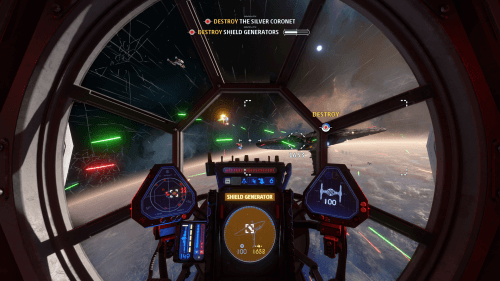
“The campaign is pretty fun though!”
It took me longer than it seems like it took most people to work my way through the campaign’s 14 missions, but after doing so, I immediately dove into the game’s practice mode which functions as a bit of a sandbox, complete with obstacle courses to race though, Fleet Battles tutorial, and then into the Fleet Battles vs AI mode, which you can run solo or coop with up to 4 other players. Fleet Battles is the main online game mode, and while the formula will probably eventually get a tiny bit old (at least versus AI) I’m intrigued by the design, which seems to borrow some concepts (most notably “creeps”) from MOBAs. It also contains phases similar to those games, though defines them in terms of fronts like some strategy games that attempt to simulate battle lines.
Each side starts out with their team of 5 players, a bunch of AI creeps. A flagship and two cruisers hold each team’s backline, while a smaller capital ship heads out to attack the enemy. Whoever wins this phase progresses to the next phase, in which they must attempt to take down the enemy cruisers. Winning that, results in a phase to finally destroy the flagship. These phases aren’t static though, and if the losing side manages to do enough damage to players (or farm enough AI creeps!) while avoiding taking too much themselves, they’ll push the winning side back and progress to the next phase themselves. This back and forth can continue for a while depending on how quickly the players can manage to take down the capital ships, and can be pretty dramatic at times, with victories pulled from the brink of total defeat not being all that uncommon. It’s a pretty cool system that mixes some objectives in with the dogfighting, while also letting us feel like we’re in the midst of a larger battle.
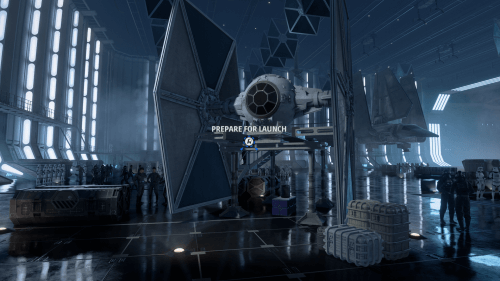
“Maximum Star Warsiness.”
There are four classes of ship you can select between lives (or swap out by flying into your flagship’s hanger) like which can all be geared and used somewhat differently, while still allowing for a fair amount of overlap. The gear you can unlock and equip can be adjusted for different purposes and preferences, but that feels more about flexibility than catering to flavor of the moment easy button meta builds. There’s also a system for unlocking cosmetic items for your pilot, your ship, and your ship’s cockpit. The whole unlock system is clearly just there for the sake of providing players with some kind of progression, but it doesn’t provide any sort of edge, and works well enough. Plus, who doesn’t want a Grogu (ok, “Baby Yoda”) bobble head on their ship’s dashboard?!
I feel like going much further into the game’s mechanics would be digging into the weeds more than anyone would likely want to read, especially coming from someone who has barely even played online where real tactics and skill are developed. If you’re interested, there are all kinds of YouTube channels and streamers with a lot more expertise than I have putting out content. Here’s one I like, for instance. This is the type of game I do wish I had a crew for though, as I can imagine sinking a ton of hours into this thing with an organized team would be insanely fun, but for numerous reasons, the timing just wasn’t right to attempt to pull something together. In any case, even without playing it online much, I love the game and am definitely happy with my purchase. If you’re a fan of the old X-wing series (or any of its contemporaries) and don’t mind the more competitive, online nature of the game, it’s hard not to give it a solid recommendation, but even if you’d rather stay out of the online lobbies completely, you might just get enough fun out of it to justify your $40.
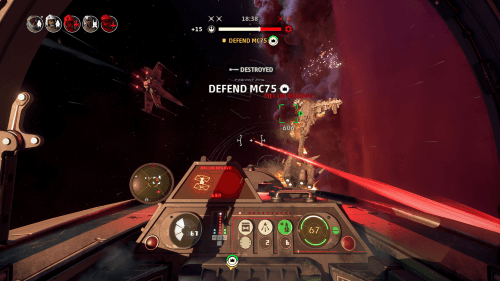
“Fleet Battles is the gift that keeps on giving.”
One more interesting thing about Star Wars: Squadrons is that despite announcing close to its launch that they wouldn’t be releasing any new content for it, Motive has continued to put out patches, new cosmetics, a new map, and they’ve even recently added two new ships – my beloved B-wing is now in the game to round out the classic roster of Rebel Alliance ships! This is all unpaid content, I should mention, because on paper this game definitely sounds like it could be yet another cynical microtransaction cash grab. Anyway, I imagine (and hope) that all of this continued support is due to the game being quite a bit more successful than originally planned. Fingers crossed that it’s done well enough to justify a future, larger sequel!
The Squadrons screenshots are mine, though the Life is Strange 2 shots were sourced from Steam Communities. I didn’t want to annoy my girlfriend with constant capture notification spam while playing through it with her.